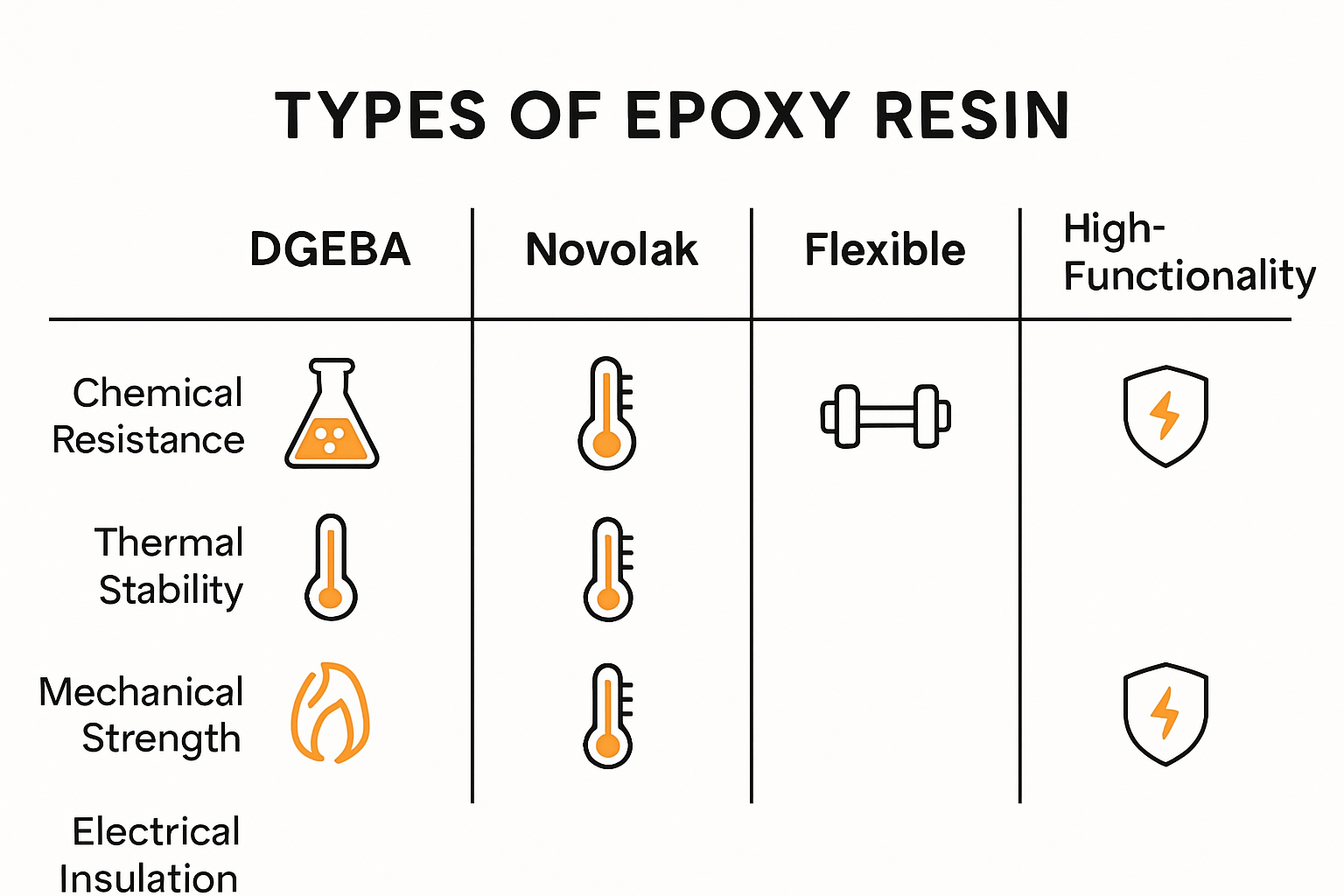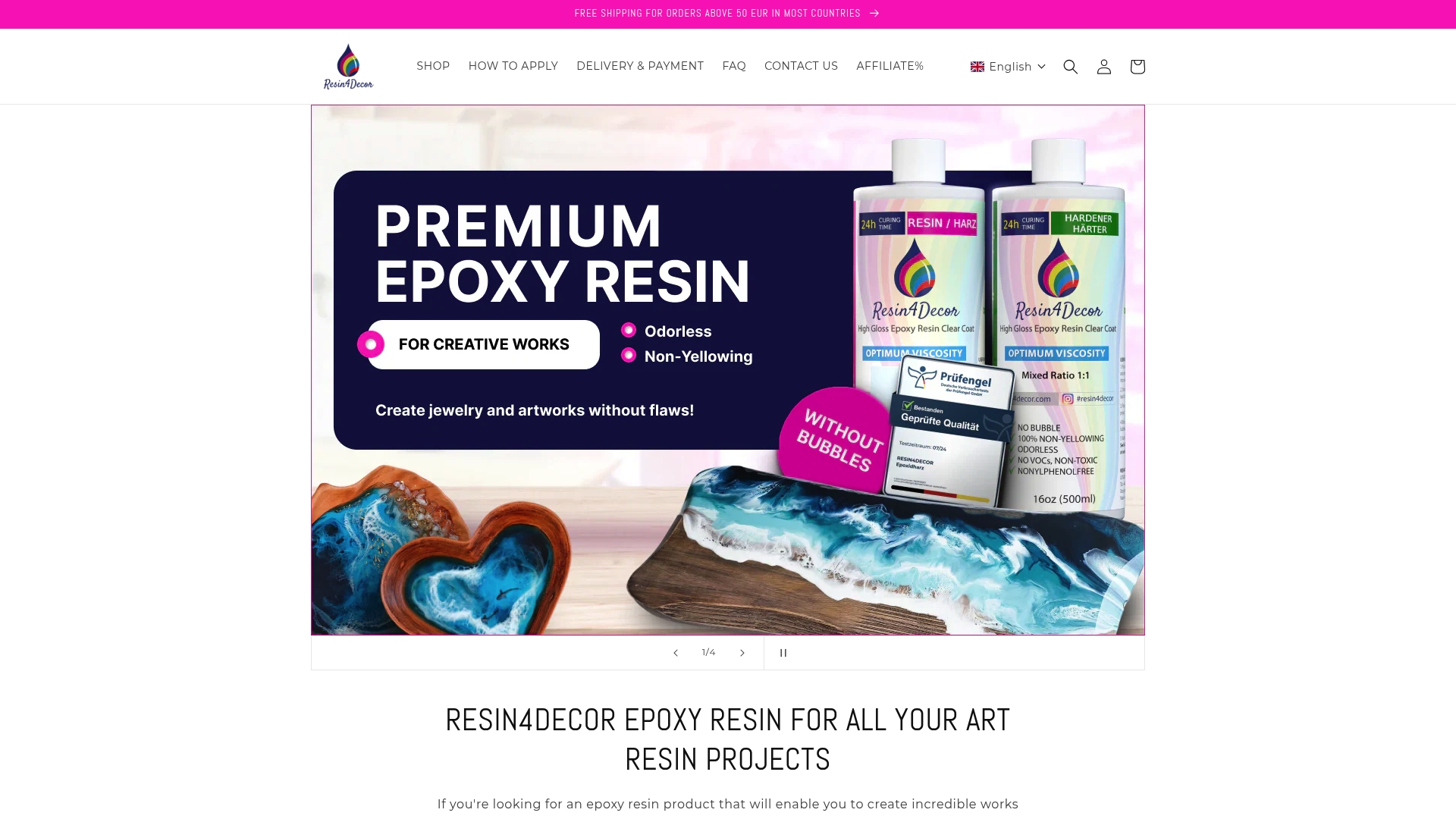
Epoxy resin is showing up everywhere these days, from bold jewelry to those stunning river tables that dominate social feeds. You might think it is just another trendy art supply, but the science behind it is next-level. What surprises most newcomers is that epoxy resin gets its strength from a reaction between epichlorohydrin and bisphenol A, creating a bond so tough that some resins can resist temperatures up to 200°C and harsh chemicals with ease. That means this material is not just for artists and crafters. Its secrets reach deep into engineering, electronics, and even eco-friendly innovation.
Table of Contents
- Defining Epoxy Resin And How It Works
- Key Epoxy Resin Types And Unique Properties
- Creative Uses For Artists, Crafters, And Small Businesses
- Tips For Safe And Successful Epoxy Resin Projects In Europe
Quick Summary
| Takeaway | Explanation |
|---|---|
| Understand epoxy resin composition. | Epoxy resin consists of epichlorohydrin and bisphenol A, enabling strong bonding. |
| Control curing conditions for desired properties. | Adjust temperature, humidity, and resin-to-harden ratio to achieve specific material characteristics. |
| Adopt safety practices when using epoxy. | Use protective gear and ensure proper ventilation to prevent exposure to harmful fumes and irritants. |
| Explore diverse artistic applications. | Epoxy resin enables the creation of jewelry, furniture, and art, expanding creative possibilities for artists and makers. |
| Stay informed about environmental regulations. | Be aware of local guidelines for resin materials to ensure safety and compliance with ecological standards. |
Defining Epoxy Resin and How It Works
Epoxy resin represents a remarkable class of synthetic polymers that have revolutionized multiple industries through their unique chemical properties and versatile applications. At its core, epoxy resin is a reactive prepolymer containing multiple epoxide groups that transform from a liquid state into a durable, hard material through a chemical process called curing.
The Chemical Composition of Epoxy Resin
Understanding epoxy resin begins with its fundamental chemical structure. Research from the Science History Institute reveals that epoxy resins are primarily created through a reaction between epichlorohydrin and bisphenol A, producing a liquid polymer with extraordinary bonding capabilities. The molecular structure allows these resins to create incredibly strong cross-linked networks when mixed with a hardening agent.
The unique characteristics of epoxy resins stem from their molecular configuration. According to Advanced Materials Research, the epoxide groups within the polymer enable a remarkable transformation during the curing process. When exposed to specific catalysts or hardeners, these groups react to form robust three-dimensional networks, resulting in a material with exceptional strength, chemical resistance, and durability.
How Epoxy Resin Cures and Transforms
The curing process is where epoxy resin truly demonstrates its extraordinary properties. When the resin is mixed with a hardening agent (typically an amine or anhydride), a chemical reaction called polymerization occurs. This process involves the epoxide groups forming strong covalent bonds, creating a rigid, interconnected molecular structure.
During curing, several critical transformations happen. The liquid resin gradually transitions from a fluid state to a solid, hard material. Temperature, humidity, and the specific ratio of resin to hardener significantly influence this process. Professional artisans and makers carefully control these variables to achieve the desired final properties, such as transparency, flexibility, or extreme hardness.
The versatility of epoxy resin comes from its ability to be customized. By adjusting the base resin, hardener type, and additional additives like pigments or fillers, creators can engineer resins with specific characteristics. This adaptability makes epoxy resin an invaluable material across numerous fields, from artistic crafting to industrial manufacturing.
Epoxy resins exhibit remarkable properties that set them apart from other polymers. They demonstrate excellent adhesion to various surfaces, outstanding electrical insulation, remarkable chemical resistance, and the ability to withstand significant mechanical stress. These characteristics make them indispensable in applications ranging from protective coatings and electronic components to intricate art pieces and jewelry.
To help clarify the main properties that distinguish epoxy resins, the following table summarizes their key advantages compared to other polymers:
| Property | Epoxy Resin | Other Common Polymers |
|---|---|---|
| Adhesion | Excellent | Moderate to Low |
| Chemical Resistance | High | Medium |
| Mechanical Strength | High | Varies |
| Electrical Insulation | Excellent | Good to Moderate |
| Thermal Stability | High (up to 200°C) | Often Lower |
Key Epoxy Resin Types and Unique Properties
Epoxy resins encompass a diverse range of synthetic polymers, each engineered with specific characteristics to meet unique industrial and artistic requirements. Understanding the various types of epoxy resins is crucial for selecting the right material for specific applications.
Standard Epoxy Resin Variants
Specialty Chemical Research indicates that epoxy resins are primarily classified based on their chemical composition and molecular structure. The most prevalent type is diglycidyl ether of bisphenol A (DGEBA), which serves as the foundational resin in numerous applications. This versatile resin offers excellent adhesion, durability, and chemical resistance.
Another significant category is novolak epoxy resins. Advanced Materials Science explains that novolaks are produced through a reaction of phenol with formaldehyde, resulting in highly viscous resins with 2 to 6 epoxy groups per molecule. These resins are particularly prized for their exceptional temperature and chemical resistance, making them ideal for high-performance engineering applications.

Specialized Epoxy Resin Formulations
Flexible epoxy resins represent a critical innovation in polymer technology. Unlike traditional rigid formulations, these resins incorporate special modifiers that enhance mechanical flexibility and impact resistance. Manufacturers achieve this by adjusting the molecular structure, allowing the resin to withstand stress and movement without compromising structural integrity.
High-functionality epoxy resins offer another remarkable advancement. These specialized formulations contain multiple reactive sites, enabling more complex cross-linking and superior mechanical properties. According to Global Engineering Specifications, these resins are particularly valuable in advanced manufacturing, electronics, and precision engineering.
Some epoxy resin types are designed for specific environmental conditions. Marine-grade epoxy resins, for instance, incorporate additional UV stabilizers and water-resistant properties. Electronic-grade epoxies feature superior electrical insulation and thermal conductivity, making them essential in circuit board manufacturing and sensitive electronic component protection.
The unique properties of different epoxy resin types emerge from their molecular engineering. Factors like crosslink density, molecular weight, and chemical additives determine characteristics such as:
- Thermal Stability: Ability to maintain structural integrity at high temperatures
- Chemical Resistance: Protection against corrosive environments
- Mechanical Strength: Capacity to withstand physical stress and impact
- Electrical Insulation: Prevention of electrical conductivity
Artists and makers benefit tremendously from this diversity. Whether creating intricate jewelry, designing architectural models, or developing protective coatings, the right epoxy resin can transform creative vision into durable, stunning reality. The key lies in understanding each resin’s unique properties and selecting the formulation that best matches the specific project requirements.
To guide makers in selecting the right epoxy resin for their needs, the table below compares major resin types and their key features:
| Epoxy Resin Type | Notable Features | Typical Applications |
|---|---|---|
| Bisphenol A (DGEBA) | Excellent adhesion and durability | Art, furniture, coatings |
| Novolak | High chemical & heat resistance | Electronics, industrial parts |
| Flexible Formulations | Enhanced flexibility, impact resistance | Jewelry, crafts, flexible parts |
| Marine-Grade | UV & water resistance, outdoor durability | Boats, outdoor furniture, river tables |
| Electronic-Grade | Superior electrical insulation, heat stability | Circuit boards, electronic sealing |
Creative Uses for Artists, Crafters, and Small Businesses
Epoxy resin has emerged as a transformative medium for creative professionals, offering unprecedented possibilities across artistic and entrepreneurial domains. Its versatility and unique properties have revolutionized how artists, crafters, and small business owners approach design, manufacturing, and product development.
Artistic Expression and Design Applications
Contemporary Art Research reveals that epoxy resin has become a premier artistic medium, enabling creators to produce intricate sculptures, paintings, and mixed-media installations. Artists leverage its transparent qualities, ability to capture and suspend objects, and capacity for vibrant pigmentation to develop stunning visual narratives.
One particularly compelling application is the creation of river tables and decorative surfaces. By combining natural wood with epoxy resin, artisans craft extraordinary pieces that showcase the interplay between organic materials and synthetic polymers. Wood Artifact Studies demonstrates how these techniques transform ordinary materials into extraordinary art pieces, ranging from functional furniture to purely aesthetic sculptures.
Small Business and Commercial Opportunities
Entrepreneurs have discovered remarkable commercial potential in epoxy resin crafting. Jewelry makers, for instance, can produce unique, high-value accessories with minimal equipment investment. The resin allows for intricate designs, embedding decorative elements like flowers, metals, or personal mementos within crystal-clear structures.
Product designers and small manufacturers utilize epoxy resin for creating custom prototypes, decorative home goods, and specialized craft items. Its ability to be molded, colored, and finished with exceptional precision makes it an ideal material for developing distinctive product lines. From coasters and serving trays to architectural models and specialized industrial components, epoxy resin offers scalable creative solutions.
The commercial landscape for epoxy resin creators is particularly exciting. Online marketplaces and social media platforms have democratized access to potential customers, allowing individual artists and small businesses to showcase and sell their unique epoxy resin creations globally. Makers can transform their creative skills into viable income streams by understanding market demands and developing specialized product offerings.
Key creative applications span multiple domains:
- Jewelry Design: Creating pendants, earrings, and statement pieces
- Home Decor: Producing river tables, wall art, and decorative objects
- Functional Art: Developing cutting boards, serving trays, and unique furniture
- Prototyping: Designing architectural models and product mock-ups
The intersection of artistic vision and technical skill defines successful epoxy resin creativity. Professionals who master color theory, understand material properties, and develop refined techniques can transform this versatile medium into compelling artistic and commercial expressions. Whether pursuing personal passion or professional opportunity, epoxy resin offers an exciting frontier for creative exploration and entrepreneurial innovation.
Tips for Safe and Successful Epoxy Resin Projects in Europe
Working with epoxy resin requires a comprehensive understanding of safety protocols and best practices. Artists, crafters, and makers must prioritize personal safety and environmental considerations to ensure successful and responsible project execution.
Personal Protective Equipment and Workspace Preparation
Centers for Disease Control and Prevention emphasizes the critical importance of comprehensive safety measures when handling epoxy resins. Professional artists should invest in high-quality personal protective equipment, including chemical-resistant gloves, safety glasses, and respiratory protection. Proper ventilation is paramount - working in a well-ventilated area or using dedicated exhaust systems can significantly reduce exposure to potentially harmful chemical vapors.
Preparing a dedicated workspace is essential for safe epoxy resin projects. Cover work surfaces with disposable protective materials, ensure adequate lighting, and maintain a clean, organized environment. Temperature and humidity control also play crucial roles in successful resin work, as environmental conditions directly impact curing processes and final product quality.
Health and Environmental Considerations
University of Utah Environmental Health and Safety highlights that epoxy components contain potential irritants and sensitizers. Artists should be particularly aware of potential allergic reactions and long-term health implications. Pregnant or breastfeeding individuals should exercise extreme caution and consider alternative materials or seek professional guidance.
Environmental responsibility is equally important. Waste management guidelines recommend minimizing chemical waste, properly disposing of unused materials, and selecting eco-friendly resin options when possible. European regulations increasingly emphasize sustainable practices, making it crucial for artists to stay informed about environmental standards.
Key safety recommendations include:
- Protective Gear: Always wear chemical-resistant gloves, safety glasses, and appropriate respiratory protection
- Workspace Setup: Ensure proper ventilation, use protective coverings, and maintain a clean work environment
Additional precautions involve understanding specific health risks associated with different resin types. Some epoxy formulations contain compounds that may cause skin irritation or respiratory sensitivities. Conducting patch tests and reviewing manufacturer safety data sheets can provide critical insights into potential risks.
Professional artists should also maintain a comprehensive safety kit, including eye wash stations, spill control materials, and first aid supplies. Consult our detailed safety guide for more in-depth information about protecting yourself during resin projects.
Beyond individual safety, European makers must remain cognizant of regional regulations governing chemical use in artistic practices. Many countries have implemented strict guidelines regarding chemical handling, waste disposal, and material composition. Staying informed about these regulations ensures not only personal safety but also compliance with local environmental standards.
Successful epoxy resin projects balance creative vision with meticulous safety practices. By investing time in understanding material properties, preparing appropriate workspace environments, and prioritizing personal protection, artists can transform their creative potential while maintaining the highest standards of professional responsibility.

Frequently Asked Questions
What is epoxy resin made of?
Epoxy resin is primarily composed of epichlorohydrin and bisphenol A, which together create a strong liquid polymer that transforms into a hard, durable material through a chemical curing process.
How does the curing process of epoxy resin work?
The curing process involves mixing epoxy resin with a hardening agent, which triggers a chemical reaction called polymerization. This reaction forms strong covalent bonds, transitioning the resin from a liquid to a solid state, resulting in a rigid and durable material.
What are the different types of epoxy resin and their unique properties?
There are several types of epoxy resin, including standard variants like diglycidyl ether of bisphenol A (DGEBA) and novolak epoxy resins. Each type has unique properties such as adhesion strength, chemical resistance, and heat stability, making them suitable for various applications.
What safety precautions should I take when working with epoxy resin?
It’s crucial to wear personal protective equipment like gloves and safety glasses and to ensure proper ventilation when working with epoxy resin. Setting up a clean workspace and being aware of potential irritants are also important for safe handling.
Ready to Transform Your Epoxy Resin Projects Into Professional Creations?
Achieving flawless results with epoxy resin can be tougher than it looks. As this guide explains, everything from choosing the right formulation to ensuring safe application makes the difference between frustration and success. Whether you are crafting intricate jewelry or that dream river table, using trusted, safety-certified materials is the key to getting the durability, shine, and clarity your work demands. Many artists struggle to find resins that are both user-friendly and safe for home studios or workshops.

Take your next step with confidence by exploring Resin4Decor.com. Our store is designed specifically for makers and artists. You will discover high-quality epoxy resin kits, vibrant pigments, and must-have accessories that meet strict European safety standards, like DIN EN 71-3 certification. Need ideas or want to see real results? Browse our detailed product pages and customer reviews. Or get safety tips right from our FAQ & Resources. Shop today and take advantage of free shipping on qualifying orders. Start creating your best projects now with Resin4Decor.com.

